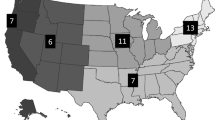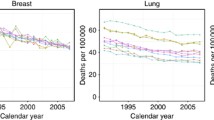Abstract
We analyzed mesothelioma incidence in the Surveillance, Epidemiology, and End Results (SEER) database over the period 1973–2005 using extensions of the age–period–cohort (APC) models. In these analyses, the usual non-specific age effects of the conventional APC models were replaced by hazard functions derived from two multistage models of carcinogenesis, the Armitage–Doll model and the two-stage clonal expansion (TSCE) model. The extended APC models described the incidence data on pleural and peritoneal mesotheliomas well. After adjustment for temporal trends, the data suggest that the age-specific incidence rates of both pleural and peritoneal mesotheliomas are identical in men and women. Driven largely by birth cohort effects, age-adjusted rates of pleural mesothelioma among men rose from about 7.5 per million person-years in 1973 to about 20 per million person-years in the early 1990s and appear to be stable or declining thereafter. Age-adjusted rates of pleural mesothelioma among women have remained more or less constant at about 2.5 per million person-years over the period 1973–2005. Age-adjusted rates for peritoneal mesothelioma in both men (1.2 per million person-years) and women (0.8 per million person-years) exhibit no temporal trends over the period of the study. We estimate that approximately 94,000 cases of pleural and 15,000 cases of peritoneal mesothelioma will occur in the US over the period 2005–2050.








Similar content being viewed by others
Notes
Incidence data for the same tumor can be downloaded using different coding schemes from the SEER registry. These distinct methods of downloading the data should yield identical numbers. For example, one can download mesothelioma incidence data using either ICD 10 codes (C45.0 for mesothelioma of the pleura and C45.1 for mesothelioma of the peritoneum, including omentum and mesentery), or using site & morphology = ‘peritoneum, omentum and mesentery’ and histology = 9,050–9,059 (mesothelial neoplasms). For peritoneum, these two codings yield highly discrepant results, with the latter coding yielding approximately four times as many tumors as the former. For pleura, the appropriate equivalents to these two approaches yield identical numbers. In this manuscript, we present the results of analyses of peritoneal mesothelioma incidence based on the second approach for the following reasons. First, this is the older method of coding and, therefore, probably less susceptible to error. Second, it appears to have been the method used in the papers by Teta et al. [9] and Boffetta [31]. We have also performed the analyses using the data obtained using the first method. Our conclusions regarding trends and model fits remain unchanged. However, our estimated rates for peritoneal mesothelioma and projected number of cases are approximately a fourth of those presented here. We would be happy to share these results with any interested reader.
References
Stayner LT, Dankovic DA, Lemen RA (1996) Occupational exposure to chrysotile asbestos and cancer risk: a review of the amphibole hypothesis. Am J Public Health 86:179–186
Yarborough CM (2006) Chrysotile as a cause of mesothelioma: an assessment based on epidemiology. Crit Rev Toxicol 36:165–187
Hodgson JT, Darnton A (2000) The quantitative risks of mesothelioma and lung cancer in relation to asbestos exposure. Ann Occup Hyg 44:565–601
Berman DW, Crump KS (2008) Update of potency factors for asbestos-related lung cancer and mesothelioma. Crit Rev Toxicol 38(S1):1–47
Berman DW, Crump KS (2008) A meta-analysis of asbestos-related cancer risk that addresses fiber size and mineral type. Crit Rev Toxicol 38(S1):49–73
Spirtas R, Heineman EF, Bernstein L, Beebe GW, Keehn RJ, Stark A, Harlow BL, Benichou J (1994) Malignant mesothelioma: attributable risk of asbestos exposure. Occup Environ Med 51:804–811
Teschke K, Morgan MS, Checkoway H, Franklin G, Spinelli JJ, van Belle G, Weiss NS (1997) Mesothelioma surveillance to locate sources of exposure to asbestos. Can J Public Health 88(3):163–168
Price B, Ware A (2004) Mesothelioma trends in the United States: an update based on surveillance, epidemiology, and end results program data for 1973 through 2003. Am J Epidemiol 159(2):107–112
Teta MJ, Mink PJ, Lau E, Sceurman BK, Foster ED (2008) US mesothelioma patterns 1973–2002: indicators of change and insights into background rates. Eur J Cancer Prev 17:525–534
Holford TR (1983) The estimation of age, period and cohort effects for vital rates. Biometrics 39:311–324
Holford TR (1991) Understanding the effects of age, period, and cohort on incidence and mortality rates. Annu Rev Public Health 12:425–457
Luebeck EG, Moolgavkar SH (2002) Multistage carcinogenesis and the incidence of colorectal cancer. Proc Natl Acad Sci USA 99:15095–15100
Meza R, Jeon J, Moolgavkar SH, Luebeck EG (2008) The age-specific incidence of cancer: phases, transitions and biological implications. Proc Natl Acad Sci USA 105:16284–16289
Jeon J, Luebeck EG, Moolgavkar SH (2006) Age effects and temporal trends in adenocarcinoma of the esophagus and gastric cardia (United States). Cancer Causes Control 17:971–981
Ries LAG, Melbert D, Krapcho M, Stinchcomb DG, Howlader N, Horner MJ, Mariotto A, Miller BA, Feuer EJ, Altekruse SF, Lewis DR, Clegg L, Eisner MP, Reichman M, Edwards BK (eds) (2008) SEER Cancer Statistics Review, 1975–2005. National Cancer Institute, Bethesda, MD. http://seer.cancer.gov/csr/1975_2005/, based on November 2007 SEER data submission, posted to the SEER web site
Armitage P, Doll R (1954) The age distribution of cancer and a multi-stage theory of carcinogenesis. Br J Cancer 8:1–12
Peto J, Seidman H, Selikoff IJ (1982) Mesothelioma mortality in asbestos workers: implications for models of carcinogenesis and risk assessment. Br J Cancer 45(1):124–135
Moolgavkar SH, Venzon DJ (1979) Two-event model for carcinogenesis: incidence curves for childhood and adult tumors. Math Biosci 47:55–77
Moolgavkar SH, Knudson AG (1981) Mutation and cancer: a model for human carcinogenesis. JNCI 66:1037–1052
Moolgavkar SH, Luebeck G (1990) Two-event model for carcinogenesis: biological, mathematical and statistical considerations. Risk Anal 10:323–341
Meza R, Hazelton WD, Colditz GA, Moolgavkar SH (2008) Analysis of lung cancer incidence in the nurses’ health and the health professionals’ follow-up studies using a multistage carcinogenesis model. Cancer Causes Control 19:317–328
Fisher RA, Corbet AS, Williams CB (1943) The relation between the number of species and the number of individuals in a random sample of an animal population. J Anim Ecol 12:42
National Center for Health and Statistics (1997) U.S. Decennial Life Tables for 1989–91, vol 1. U.S. Department of Health and Human Services, Hyattsville, Maryland
Martin JA, Hamilton BE, Sutton PD, Ventura SJ, Menacker F, Kirmeyer S, Munson ML (2007) Births: final Data for 2005. Natl Vital Stat Rep 56(6):1–101
U.S. EPA (1986) Airborne asbestos health assessment update. EPA/600/8-84/003F
Nicholson WJ, Perkel G, Selikoff IJ (1982) Occupational exposure to asbestos: population at risk and projected mortality—1980–2030. Am J Ind Med 3:259–311
Doll R, Peto R (1978) Cigarette smoking and bronchial carcinoma: dose and time relationships among regular smokers and lifelong non-smokers. J Epidemiol Community Health 32:303–313
Hemminki K, Li X (2003) Time trends and occupational risk factors for peritoneal mesothelioma in Sweden. J Occup Environ Med 45:451–455
Burdorf A, Jarvholm B, Siesling S (2007) Asbestos exposure and differences in occurrence of peritoneal mesothelioma between men and women across countries. Occup Environ Med 64:839–842
Seidman H, Selikoff IJ (1990) Decline in death rates among asbestos insulation workers 1967–1986 associated with diminution of work exposure to asbestos. Ann N Y Acad Sci 609:300–318
Boffetta P (2007) Epidemiology of peritoneal mesothelioma: a review. Ann Oncol 18:985–990
Author information
Authors and Affiliations
Corresponding author
Electronic supplementary material
Below is the link to the electronic supplementary material.
Rights and permissions
About this article
Cite this article
Moolgavkar, S.H., Meza, R. & Turim, J. Pleural and peritoneal mesotheliomas in SEER: age effects and temporal trends, 1973–2005. Cancer Causes Control 20, 935–944 (2009). https://doi.org/10.1007/s10552-009-9328-9
Received:
Accepted:
Published:
Issue Date:
DOI: https://doi.org/10.1007/s10552-009-9328-9




